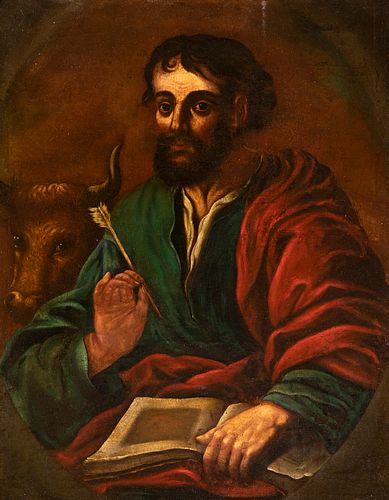Spanish school; XVII century. "San Lucas". Oil on canvas. Relined.
Lot 39
About Seller
Setdart Auction House
Carrer Aragó 346
Barcelona
Spain
Setdart Subastas was born in 2004 and is currently the first online art auction in Spain with solidity, prestige and reliability guaranteed by our more than 60,000 users. Setdart has a young, dynamic and enterprising team ready to successfully manage the purchase and sale of art works through custom...Read more
Estimate:
EUR€2,500 - EUR€3,000
$2,688.17 - $3,225.81
Absentee vs Live bid
Two ways to bid:
- Leave a max absentee bid and the platform will bid on your behalf up to your maximum bid during the live auction.
- Bid live during the auction and your bids will be submitted real-time to the auctioneer.
Bid Increments
| Price | Bid Increment |
|---|---|
| EUR€0 | EUR€10 |
| EUR€200 | EUR€25 |
| EUR€500 | EUR€50 |
| EUR€1,000 | EUR€100 |
| EUR€3,000 | EUR€200 |
| EUR€5,000 | EUR€500 |
| EUR€10,000 | EUR€1,000 |
| EUR€20,000 | EUR€2,000 |
| EUR€50,000 | EUR€5,000 |
About Auction
By Setdart Auction House
Nov 3, 2021
Set Reminder
2021-11-03 08:00:00
2021-11-03 08:00:00
America/New_York
Bidsquare
Bidsquare : OLD MASTERS
https://www.bidsquare.com/auctions/setdart-auction-house/old-masters-7786
Setdart Auction House sofia@setdart.com
Setdart Auction House sofia@setdart.com
- Lot Description
Spanish school; XVII century. "San Lucas". Oil on canvas. Relined. Measurements: 79 x 60 cm; 100 x 84,5 cm (frame). Devotional image that presents St. Luke the Evangelist inscribed in a border. The saint is seated with his gospel open before the spectator, and leaning on his knees. In one of his hands he holds a pen, while with the other he grasps the book. His gaze is directed directly towards the viewer, thus establishing contact with him, in an attitude of certain complicity. The scene ends with the presence of the bull, of which only its head is visible. Hidden behind the figure of the saint, the animal located in the left zone of the composition, also directs his sight towards the front. It is the presence of the bull, which defines the iconography of the evangelist, although it is worth mentioning that it is common the representation of the saint dressed in green tunic and red mantle, as can be seen in this work, and arranged with his pen and his gospel. As for the aesthetic representation, it follows the parameters of the Spanish baroque, using earthy and dark tones, on which a focus of light is directed. Saint Luke the Evangelist is considered by Christian tradition to be the author of the Gospel that bears his name, and also of the Acts of the Apostles. He was Paul's beloved physician, although not an apostle of Jesus, of probable Syrian origin, possibly converted to the Christian faith when the followers of Jesus, persecuted in Jerusalem and Caesarea, sought refuge outside Palestine, carrying with them the message of Christ. To him is also attributed the first portrait of the Virgin, so he is considered the patron saint of painters.
- Shipping Info
-
In-house shipping available. Please inquire at admin@setdart.com.
-
- Buyer's Premium



 EUR
EUR CAD
CAD AUD
AUD GBP
GBP MXN
MXN HKD
HKD CNY
CNY MYR
MYR SEK
SEK SGD
SGD CHF
CHF THB
THB















